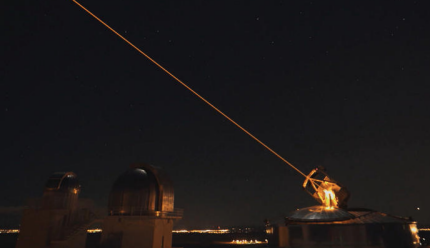Antisatellite race heats up with China, Russia
The Air Force is exploring new antisatellite technologies -- but keeping quiet about which ones -- in response to Chinese tests and Russia's hard line.

An Air Force laser test at Kirkland Air Force Base, N.M.; analysts think lasers that could blind, but not destroy, satellites are a likely option.
Congress added more than $32 million to the Air Force's space budget in fiscal 2015 to study future antisatellite capabilities, including offensive and "active defense" capabilities. It also instructed DOD to "conduct a study of potential alternative defense and deterrent strategies in response to the existing and projected counterspace capabilities of China and Russia."
Concerns have grown in the aftermath of Chinese antisatellite tests, most recently in July 2014, that demonstrated the capability to destroy military communications satellites, perhaps even those in geostationary orbits. Analysts suspect the test involved a prototype kinetic kill weapon. That possibility has U.S. military officials especially nervous given the debris fields that could be generated in a space conflict.
These worries have also been fueled by strained relations with Russia that have stalled international efforts to bolster transparency and confidence-building measures related to outer space. While progress was reported in strengthening an existing regime, observers said Moscow began digging in its heels when fighting started last year in Ukraine.
Meanwhile, Air Force officials have taken a harder line on counterspace since the Chinese antisatellite, or ASAT, tests. Before the 2014 test, China had in 2007 destroyed one of its old weather satellites using a ballistic missile, and in 2013 conducted another apparent ASAT test. China has denied that the recent tests involved ASAT^ capabilities.
"We’re aggressively looking at our current capabilities and our future capabilities to figure out what we have to do to prepare for those threats," Air Force Gen. John Hyten, commander of U.S. Space Command, told reporters earlier this week. Hyten cited ongoing Russian and Chinese counterspace development, including laser weapons and microsatellites. "They are very close to fruition, and we need to be prepared for that," Hyton was quoted as saying.
"They are testing and investing," Air Force Secretary Deborah Lee James told “60 Minutes” recently, and "that is worrisome to the United States." Hence, the Pentagon will spend an extra $5 billion over the next five years to protect military satellites.
Space security analysts have noted the steady drum beat from the Pentagon over ASAT development. "There's a clear rhetorical strategy here," said Theresa Hitchens, senior research scholar at the Center for International and Security Studies at the University of Maryland.
"The U.S. intelligence community and military leaders have been spooked by continued Chinese ASAT testing, especially the last test which took place at an altitude near [geosynchronous orbit] where very important national security satellites reside," added Hitchens, who previously directed the United Nations Institute for Disarmament Research in Geneva.
Referring to additional funding for counterspace development, Hyton cited the need for more resilient next-generation satellites with defensive capabilities integrated into their designs. That translates primarily into satellites that could maneuver to avoid attack. Beyond that, U.S. defense officials have not elaborated on what "active defense" technologies are being developed, nor will they discuss counterspace capabilities beyond the satellite-jamming Counter Satellite Communications System deployed in 2004.
Along with the Chinese ASAT tests, Moscow has also taken a harder line on space cooperation since the outbreak of hostilities in Ukraine. Hitchens said those tensions "have translated up the chain to the White House. As a result, we've been hearing more aggressive rhetoric out of the U.S. space community regarding 'deterrence' and response."
The high ground of space remains vital to U.S. military operations. According to CBS News, citing a White House report, the U.S. military spends as much as $25 billion annually on space operations when spy satellites and other classified operations are included.
When asked during a recent “60 Minutes” interview whether the U.S. military had other ASAT capabilities capabilities beyond the ground-based jamming system and maneuvering satellites, Hyton replied: "That's not it, but that's all I can tell you."
Beyond Hyton's recent comments and a Space Command fact sheet on U.S. military satellites operating in geosynchronous orbit, the Air Force has said little about what new ASAT capabilities it is developing. Based on the fear of creating new debris fields in space—space junk that could knock out critical infrastructure on Earth—analysts think laser technologies that could blind but not destroy satellites are a likely focus of Air Force development.
Then there is the larger question of deterring China and Russia, each of which understands the United States has an ASAT capability.
"The question is whether a harder line approach will deter Russia and China or push them into even more troubling developments, and begin an ASAT race," Hitchens said, adding that such a competition "would increase risks to all space users."